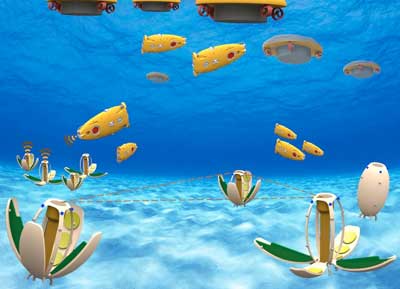| Sep 15, 2020 |
Aquatic robots monitor how climate change impacts Venice's lagoon
|
|
(Nanowerk News) Venice is synonymous with canals. But the next time you’re taking in ‘La Serenissima’ via a romantic gondola ride, you might want to keep an eye out for swimming robots. That’s because a team of researchers with the EU-funded subCULTron project has ‘released’ a swarm of over 120 aquatic robots into Venice’s lagoon.
|
 |
| Self-directing robots to monitor water conditions in the Venice lagoon. (Image: subCULTron)
|
|
Although it may seem like a scene out a science fiction movie, these autonomous robots play an essential role in the city’s efforts to mitigate the effects of climate change and pollution.
|
|
“Climate change, pollution, mass tourism, invasive species – these are just some of the critical challenges that Venice’s lagoon face,” says Ronald Thenius, a researcher at the University of Graz in Austria and member of the subCULTron team. “New challenges require new solutions, and for us, the most efficient way of solving these particular challenges is with robots.”
|
A swarm of underwater robots
|
|
The project’s main objective was to develop a state-of-the-art tool for monitoring the underwater environments of large lagoon areas like Venice. However, unlike traditional monitoring systems, the subCULTron system aimed to provide spatially distributed monitoring. This meant it needed to be able to measure several different places at exactly the same time and over a very long period. To accomplish this, researchers relied on a large group, or swarm, of relatively small and cheap robots.
|
|
“This ‘swarm approach’ is in stark contrast to the more common practice of using one large, and thus expensive, robot,” says Thenius. “Our approach lets us take multiple measurements at the same time and from different places and enables the robot swarm to act autonomously and in a decentralised manner.”
|
|
According to Thenius, it is this unique self-organised architecture that allows the robotic system to not only take measurements, but also react to them. Thus, if the system determines that a certain measurement is no longer necessary, it can automatically reposition parts of the swarm to a more interesting location or change the rate of sampling happening in different areas.
|
Mussels, fish, and lily pads
|
|
The subCULTron system consists of three different types of robots: aMussels, aFish, and aPads. “The aMussels serve as the system’s collective long-term memory, allowing information to stay beyond the runtime of the other robot types,” explains Thenius. “These mussels monitor the natural habitat of the lagoon’s fish, including biological agents like algae and bacteria.”
|
|
The aPads, on the other hand, float on the water’s surface like a lily pad. These robots serve as the system’s interface with human society, delivering energy and information from the outside world to the swarm. Between these two layers swim the aFish, which are essentially artificial fish that move through the water to monitor and explore the environment and send the collected information to the mussels and lily pads.
|
|
“As soon as the swarm ‘decides’ that one spot deserves more attention, several aMussels will surface and be transported to the new region of interest via the aPad,” comments Thenius. “This way, the swarm can move through the lagoon and investigate different phenomena completely autonomously.”
|
Powered by mud
|
|
In addition to the robots themselves, another important outcome of the project is the innovative way the robots are powered: mud. “One big breakthrough is the unprecedented proof of concept that an autonomous robot can run only on microbial fuel cells (MFCs),” says Thenius.
|
|
An MFC is a bio-electrochemical system that creates an electric current using bacteria and a high-energy oxidant, such as the oxygen found in the mud of a lagoon floor.
|
|
“Although this technology has been tested before in laboratories, subCULTron was the first to demonstrate that it can be used in the field by autonomous robotics,” concludes Thenius. “This breakthrough opens the doors to a range of exciting new types of technologies and innovations!”
|

